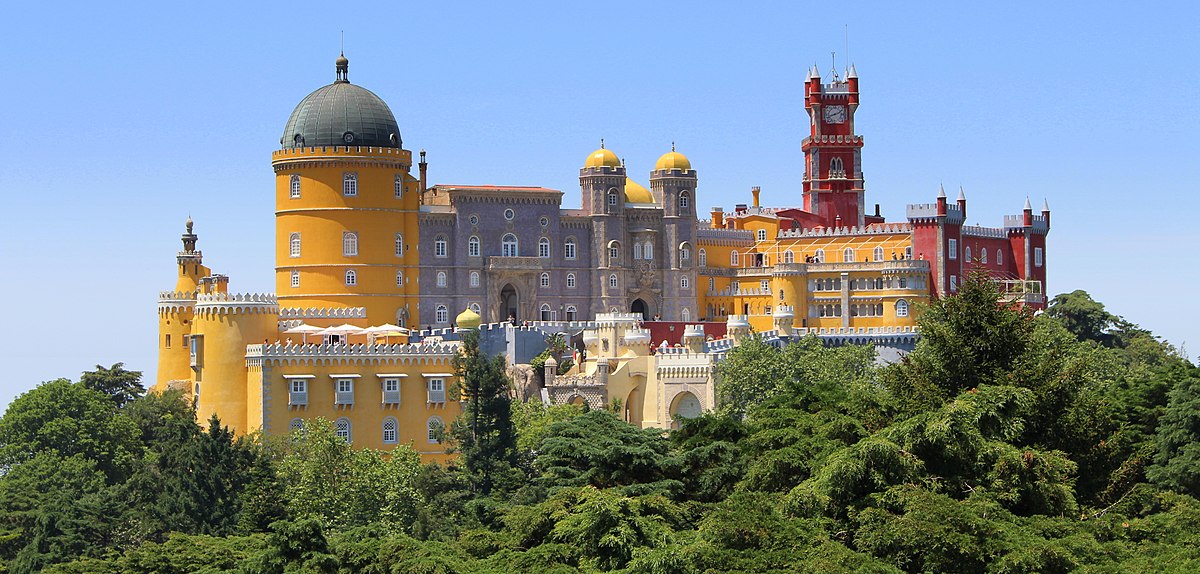
Sintra
Tucked away in the lush hills just outside of Lisbon, Sintra is a magical destination that feels like stepping into a fairytale. This UNESCO World Heritage Site is renowned for its stunning palaces, ancient castles, and mystical gardens, all set against a backdrop of verdant forests. Sintra’s blend of history, culture, and natural beauty has captivated visitors for centuries, making it one of Portugal’s most enchanting places to explore.
A Historical Gem
Sintra has long been a place of refuge for royalty and nobility. Its cool climate and scenic landscapes attracted Portuguese monarchs as far back as the 12th century, when King Afonso I conquered the region from the Moors. The Moors had previously built a castle on the highest point of the hills, and its ruins still stand today as the Castelo dos Mouros, offering panoramic views of the surrounding countryside.
During the 19th century, Sintra became a haven for European Romanticism. Wealthy aristocrats built extravagant palaces and estates, transforming Sintra into a symbol of artistic and architectural imagination. The most iconic of these is the Palácio da Pena, a colorful, eclectic masterpiece that crowns one of Sintra’s highest peaks. Over the years, Sintra’s beauty and historical significance have only grown, drawing travelers and creatives alike to marvel at its unique atmosphere.
Top 5 Unique Characteristics of Sintra
1. Palácio da Pena
The most recognizable landmark in Sintra, Palácio da Pena looks like something straight out of a storybook. Perched on a hilltop, this palace is a mix of vibrant colors and architectural styles, blending Gothic, Moorish, and Renaissance elements. Built in the 19th century for King Ferdinand II, it is one of the most important examples of Romantic architecture in Europe. The palace’s whimsical design and sweeping views of the Atlantic Ocean make it a must-visit for any traveler to Sintra.
2. Quinta da Regaleira
One of Sintra’s most intriguing sites, Quinta da Regaleira is an estate that feels like a mystical world of its own. The property features a palace, chapel, and extensive gardens filled with hidden grottos, tunnels, and secret passageways. The Initiation Well, a spiral staircase that descends into the earth, is a symbol of the estate’s connection to mysticism and secret societies. The gardens are designed to represent the journey of life and spiritual discovery, making it a fascinating place for those who love history and symbolism.
3. Castelo dos Mouros
The Moorish Castle, or Castelo dos Mouros, offers a glimpse into Sintra’s medieval past. Built by the Moors in the 8th or 9th century, the fortress was later taken by Christian forces during the Reconquista. Its stone walls snake along the hillsides, providing visitors with breathtaking views of the surrounding landscape and the Atlantic Ocean. A walk along its ramparts is like traveling back in time.
4. Monserrate Palace
Monserrate Palace is a stunning blend of Gothic, Moorish, and Indian influences, set in beautifully landscaped gardens filled with exotic plants from around the world. Built in the 19th century, the palace is one of Sintra’s hidden gems. Its intricate designs, domes, and arches give it an exotic, almost otherworldly feel, making it a favorite among visitors seeking a quieter but equally enchanting experience in Sintra.
5. Sintra’s Microclimate and Lush Nature
Sintra’s unique microclimate is a key characteristic that sets it apart from other Portuguese destinations. Nestled in the hills, the town enjoys cooler temperatures and higher humidity, which supports its lush vegetation and dense forests. This natural beauty is best appreciated in the Sintra-Cascais Natural Park, where visitors can hike trails leading through verdant landscapes, with the possibility of spotting rare flora and fauna along the way.
Sintra Today: A Timeless Destination
Though it is a small town, Sintra’s significance in modern-day tourism and culture cannot be overstated. It remains a haven for artists, writers, and thinkers inspired by its beauty and rich history. The town is also a favorite day-trip destination from Lisbon, drawing visitors to its palaces, gardens, and stunning viewpoints.
Sintra’s historical significance, combined with its commitment to preserving its natural and architectural heritage, has made it one of Portugal’s most cherished cultural treasures. It continues to play an important role in Portuguese tourism, offering a window into the country’s past while remaining vibrant and full of life.
Fun Facts About Sintra
Lord Byron, the famous English poet, once described Sintra as a “glorious Eden” during his travels in the early 19th century.
The Palácio da Pena is one of the Seven Wonders of Portugal, recognized for its unique and eclectic architectural style.
Sintra was the first center of European Romantic architecture, influencing many other architects and designers throughout Europe.
Sintra’s local pastry, "travesseiros," is a delicious treat made of puff pastry filled with almond cream and sugar, a must-try for food lovers.
The town was a favorite summer residence of Portuguese royalty due to its cooler temperatures compared to Lisbon.
Whether you’re drawn by its breathtaking palaces, mystical gardens, or the allure of its history, Sintra promises an unforgettable journey through one of the most picturesque and magical places in Portugal.